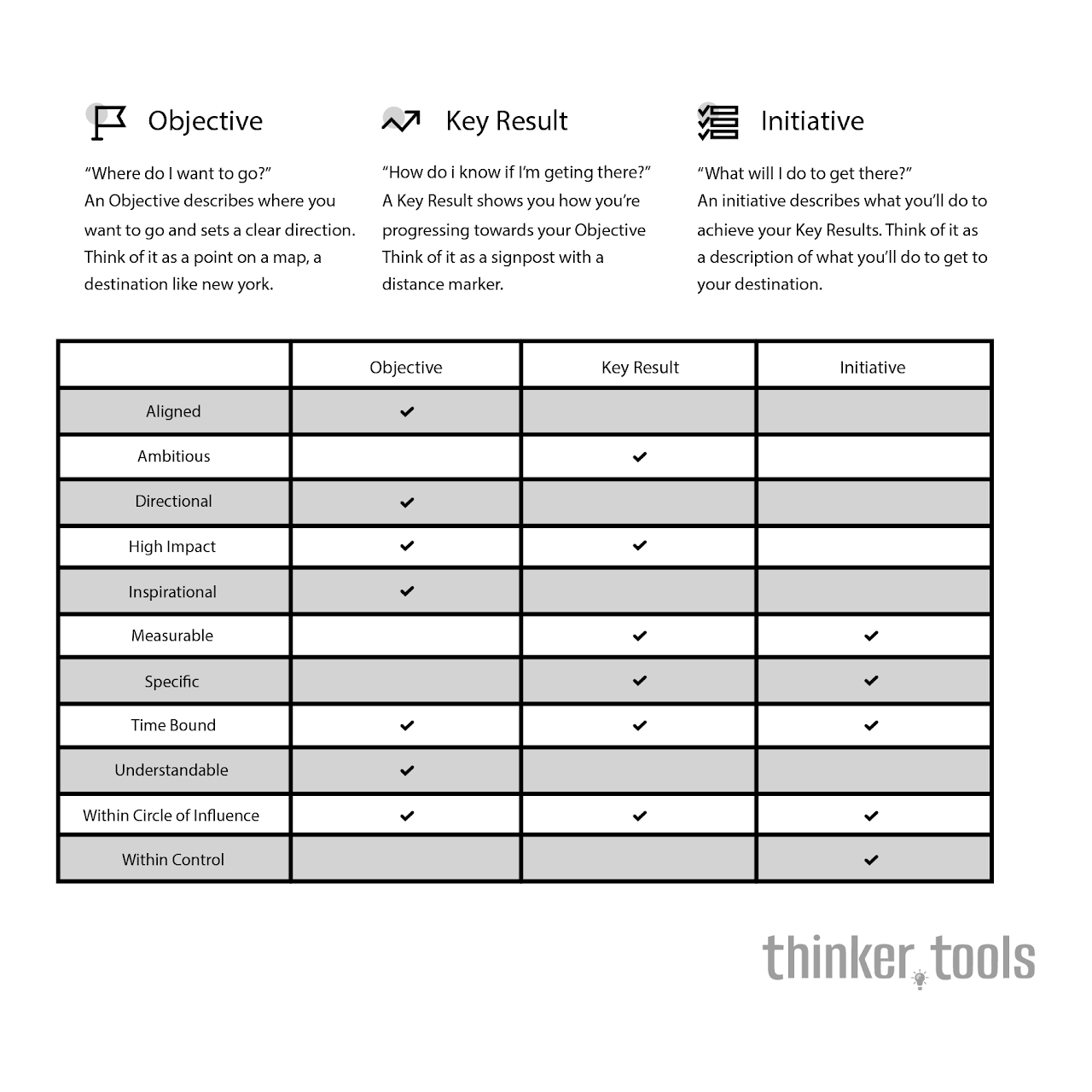
What is OKR?
OKR is a goal-setting framework that pairs qualitative Objectives with quantitative Key Results:
- Objectives: Ambitious, qualitative goals that inspire and provide direction ("Where do we want to go?")
- Key Results: Specific, measurable outcomes that indicate progress toward the objective ("How will we know we're getting there?")
Each objective typically has 3-5 key results, creating a clear connection between aspiration and achievement.
The History and Origin
OKRs were invented by Andy Grove at Intel in the 1970s, building on Peter Drucker's Management by Objectives (MBO) concept. Grove's innovation was to simplify the process and add the crucial element of measurable key results. John Doerr, who learned the system at Intel, later introduced OKRs to Google in 1999 when the company had just 40 employees. Google's spectacular growth while using OKRs catapulted the framework into the mainstream, making it the goal-setting system of choice for ambitious organizations worldwide.
How to Use OKRs: Step by Step
Step 1: Set Inspiring Objectives
Create 3-5 objectives that are:
- Ambitious and inspiring
- Qualitative and memorable
- Time-bound (typically quarterly)
- Aligned with your mission
Example: "Become the most trusted source of financial advice for millennials"
Step 2: Define Measurable Key Results
For each objective, create 3-5 key results that are:
- Specific and unambiguous
- Measurable with a number
- Achievable but challenging
- Relevant to the objective
Example Key Results for the above objective:
- Increase monthly active users from 50,000 to 150,000
- Achieve a Net Promoter Score of 70+
- Publish 50 high-quality financial guides with 80%+ user satisfaction
Step 3: Set Stretch Goals
OKRs should be ambitious. Achieving 70% of your key results is considered success. If you're consistently hitting 100%, your goals aren't ambitious enough.
Step 4: Cascade and Align
In organizations, OKRs cascade from company level to team level to individual level, ensuring everyone moves in the same direction.
Step 5: Make Them Public
Transparency is crucial. Share OKRs openly so everyone understands what others are working toward.
Step 6: Regular Check-ins
Review progress weekly or bi-weekly. OKRs aren't "set and forget"—they require active management.
Step 7: Score and Reflect
At the end of the period, score each key result (typically 0.0 to 1.0). Reflect on learnings and apply them to the next cycle.
Practical Examples
Example 1: Personal Health OKR
Objective: Transform my health and fitness by summer
Key Results:
- Reduce body weight from 200 to 180 pounds
- Complete a 5K run in under 25 minutes
- Maintain a resting heart rate below 60 bpm
- Log 10,000 steps daily for 85% of days
Example 2: Startup Growth OKR
Objective: Establish market leadership in our category
Key Results:
- Grow monthly recurring revenue from $100K to $500K
- Achieve 50% market share in our target segment
- Maintain customer churn below 5%
- Launch in 3 new geographic markets
Example 3: Team Performance OKR
Objective: Build a world-class engineering culture
Key Results:
- Reduce average bug resolution time from 5 days to 2 days
- Increase deployment frequency from monthly to weekly
- Achieve 90% engineer satisfaction score
- Complete 100% of planned training programs
Benefits and Life Improvements
Focus and Prioritization
OKRs force you to choose what matters most. By limiting objectives and key results, you avoid the trap of trying to do everything and achieving nothing.
Alignment and Transparency
When everyone's OKRs are visible, teams naturally align their efforts. This transparency eliminates duplicate work and ensures everyone pulls in the same direction.
Ambitious Thinking
The stretch nature of OKRs pushes people beyond incremental improvements. This "moonshot thinking" often leads to breakthrough innovations.
Measurable Progress
Unlike vague goals, OKRs provide clear metrics for success. You always know exactly where you stand and what needs improvement.
Agility and Adaptation
Quarterly OKR cycles allow rapid adjustment to changing conditions. You're not locked into annual plans that become obsolete.
Engagement and Motivation
Clear objectives linked to measurable results create a sense of purpose and progress. People feel more engaged when they understand how their work contributes to larger goals.
Learning Culture
The regular scoring and reflection process turns failures into learning opportunities. This growth mindset accelerates both personal and organizational development.
Transform Your Goal Achievement
OKRs represent a fundamental shift in how we approach goals—from vague wishes to concrete commitments, from annual planning to quarterly sprints, from hidden agendas to radical transparency. Whether you're leading a multinational corporation, running a small team, or pursuing personal growth, OKRs provide the structure and clarity needed to achieve extraordinary results.
Start small: Choose one important area of your life or work and create your first OKR. Set an inspiring objective, define measurable key results, and commit to the process. As you experience the power of this framework, expand its use to other areas. Remember, the magic of OKRs isn't in perfect execution—it's in the disciplined thinking, clear measurement, and relentless focus on what truly matters. Your journey from ordinary to extraordinary starts with your first OKR.